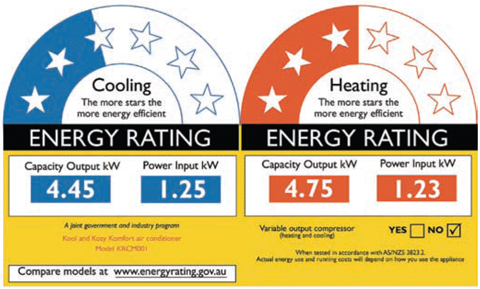Energy
Designing homes to conserve energy and use it efficiently, from sources that cause least environmental harm.
Selecting energy-efficient appliances
Energy use can be minimised by the selection of energy efficient appliances.
On this page:
- Energy rating and labeling schemes
- Running costs calculator
- Ovens
- Cooktops
- Microwave ovens
- Fridges and freezers
- Clothes washers and dryers, and dishwashers
- Kitchen energy efficiency.
There are two factors to consider. The first is the type of appliance – some are more efficient than others (for example, induction elements are more efficient than other types of electric cooktop element). The second is to use a rating or labeling scheme to select an efficient model for the type of appliance specified.
Energy rating and labeling schemes
Energy performance labelling schemes and standards focus on energy consumption, but of course this has an impact on greenhouse gas emissions too. For example, the government’s Gen Less website points out that a clothes dryer with 10 stars on the energy rating label emits 77% fewer emissions than a similar dryer with only 1 star.
Energy rating labels
Energy rating labels are compulsory for household fridges and freezers, clothes washers and dryers, dishwashers, televisions, computer monitors, air conditioning units and air-to-air heat pumps. The labels contain a star rating for energy efficiency – each star means a 10% saving in running costs. For air conditioning units, ratings are given separately for heating and cooling.
Fridges and freezers and heat pumps/air conditioners can get up to 10 stars – extra stars appear in a crown above 6-star band.
The labels also show energy consumption per year. This is an important consideration, as a large appliance with a high star rating will use more power than a smaller appliance with a lower rating for the same level of use. Use the annual energy consumption figures to compare appliances of a similar type and size. Air conditioning units/heat pumps have different measures of power use: capacity output is the amount of heating or cooling (kWh) produced by a heat pump at its rated capacity, at 7˚C; power input is the amount of electricity the product uses (kWh) to produce cool/hot air. For dishwashers and washing machines, the labels are also required to show information about standby power.
Minimum Energy Performance Standards (MEPS)
The Minimum Energy Performance Standards (MEPS) set minimum energy efficiency requirements for fridges, freezers, electric hot water storage units, gas water heaters, televisions, air conditioning units/heat pumps, fluorescent lights and compact fluorescent lights (CFLs). All of these products must meet the MEPS.
Efficient appliance calculator
The government’s Gen Less website has a efficient appliance calculator for whiteware appliances, televisions, computer monitors and heat pumps. You answer a few questions about your appliance use, the size of appliance and its energy rating, and the calculator tells you the annual running cost. You can make comparisons between brands, models and sizes.
Ovens
Cooking accounts for 5% of the electricity used by the average New Zealand household. Generally, only a small amount of the energy is actually used for cooking – the rest is in heating the air around the food that is being cooked.
Gas is more efficient than electric for ovens but gas requires a well ventilated kitchen. An air extract system is also recommended.
An electric oven with a fan heats more efficiently than a standard oven. Self-cleaning ovens are more efficient than other types because they have more insulation.
Wood-burning stoves tend to be regarded as a sustainable cooking alternative, but a lot of heat is lost up the flue and much of it also goes into the room. They have less control and produce potentially harmful emissions.
Cooktops
Cooktop (hob) options include gas or electric.
When selecting the energy supply for a cooktop, gas is generally more efficient at transferring heat than electric. If reticulated gas is not available, bottled gas is a viable alternative.
There are two types of commonly available electric cooktop, radiant-ceramic and induction:
- Radiant cooktops have heating elements below the ceramic top. They are slower to heat up and generally consume more energy.
- Induction cooktops produce a magnetic field, which transfers energy into suitable metal cookware (not all types of cookware can be used on induction cooktops). Temperature changes happen quickly, which makes for faster cooking. The induction cooktop itself remains reasonably cool. Induction cooktops can be up to twice as energy efficient as other types of cooktops.
Microwave ovens
A much greater proportion of the energy used by a microwave oven is used for cooking compared to a conventional oven (which uses a lot of energy heating air). Microwaves also cook food in a shorter time. They are therefore much more energy efficient than conventional ovens. (For heating water, however, kettles are more efficient than microwaves.)
In addition to standard microwaves there are also microwave ovens with a grill, and convection/combination ovens that can microwave, bake and grill.
Fridges and freezers
Fridges and freezers account for around 17% of the electricity used by the average New Zealand household. They are the biggest consumers of energy of all household appliances because they operate continuously.
Their efficiency decreases as the temperature of their surroundings increases. Efficiency also depends on the level of insulation
They should be located in a cool area, not in direct sunlight, and away from cookers, dishwashers and other heat sources. A 75 mm gap should be left around all sides of a fridge or freezer.
Fridges and freezers should be large enough to comfortably meet the needs of the household and no larger. Some very large fridge/freezers consume twice as much electricity as smaller models.
Clothes washers and dryers and dishwashers
Clothes washers and dryers and dishwashers should be sized appropriately for the household. If too small, they will be used more often; if too large, they require more energy to run.
Considerations when purchasing an appliance:
- Front-loading washing machines are more energy-efficient and water-efficient than top-loaders. They also generally have a higher spin speed, which means they remove water from clothes more efficiently.
- Clothes dryers that expel warm, moist air must be vented to the outside to ensure damp air is removed from the house. This makes a much healthier indoor environment as well as indirectly reducing the space heating load. Condensing clothes dryers and heat pump dryers do not need to be vented.
- It is more energy-efficient and water-efficient to use a dishwasher than to wash dishes by hand.
Clothes dryers that use a small heat pump to heat the air that dries the clothes are available. While this makes them very energy-efficient, they are currently three or four times more expensive to buy than conventional dryers. They’ll need to be used more than once every day to make them an economical purchase.
Kitchen energy efficiency
The energy efficiency of the kitchen can be improved if:
- it has a rangehood above the cooking area to extract moisture without removing a large quantity of heated air from the rest of the house. The moisture collected by the rangehood must be vented outside the house.
- the oven is not located beside a refrigerator or freezer.
More information
Energy ratings
- www.smarterhomes.org.nz – appliances
- www.eeca.govt.nz – energy rating labels
- www.energyrating.gov.au
MEPS
- www.eeca.govt.nz – minimum energy performance standards
Updated: 02 May 2023


